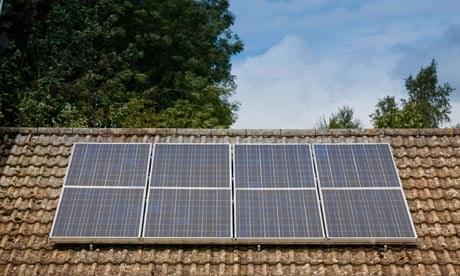The global deployment of renewable energy from wind, solar and biofuels grew in 2012 but the income from the sector remained flat due to the plummeting costs for solar photovoltaic panels.
The revenue for the three technologies increased by 1% globally to $249bn in 2012, according to the Clean Energy Trends 2013 report released on Tuesday by renewable energy research firm Clean Edge.
"We always knew each doubling of [solar PV] installation would reduce prices about 18%," the Clean Edge founder, Ron Pernick, told the Guardian. Pernick said that prices were falling because the sector was expanding rapidly, doubling every one to two years. New solar PV installations expanded to 31GW in 2012, while revenues decreased by $12bn – or 19% – to $80bn.
Back in 2000, solar revenues were only $2.5bn and prices were set to reach so-called grid parity – costing the same as conventional energy sources - by 2020. Solar costs have already fallen from $7.50 per watt to $2.50 and are projected to reach $1.50 within five years, equivalent to between 5 and 12 US cents per kilowatt hour.
"$1.50 really is the holy grail," said Pernick, who said that extending US tax incentives already available to the oil and gas and real estate industries could drive up investment even further.
Overall, renewable energy increased its market share of new energy investments from 1.1% in 2001 to 19% in 2012. Global wind capacity increased by 45GW, with take-up in the US surpassing natural gas investment. In total, renewable energy made up 49% of all new generating capacity in the US.
Moves by expert investors – "smart" money – accounted for much of the scale-up in renewables. Warren Buffet's Mid-American Energy Holdings added over 500MW through acquisitions such as the $2bn purchase for Antelope Valley Solar Project that feeds Californian utility, Southern Edison. Google was also active, with its Texas windfarm acquisition taking its combined solar and wind capacity to 2GW.
Biofuels added 3.5bn gallons of ethanol and biodiesel to supplies, increasing the total capacity to 31bn gallons with revenues worth $95 billion and projected to reach $122bn by 2022.
Looking to the future, the report suggests innovation can continue to improve the performance of renewable technologies, including using biomimicry ideas to imitate nature. Curved wind turbine blades inspired by humpback whale fins have increased wind energy capture over flat blades by 25%, while mimicking photosynthesis using dye-sensitised solar cells based on titanium oxide instead of silicon is proving effective in low-light situations. In addition, energy efficiency developments like Nest's 'learning thermostat' and smartphone apps for thermostat control will help connect web and smart-grid technologies.
Geothermal energy also has major source potential, according to the report. The US has a quarter of the world's existing geothermal capacity of 11GW but Kenya expects geothermal to generate 30% of its power by 2020. Elsewhere, the world bank is investing $300m in Indonesia's estimated potential of 27GW of geothermal energy.
A report from Bloomberg New Energy Finance in January found that investment in clean energy projects dipped 11% in 2012, but said the $269bn invested still made 2012 the second most biggest year on record for the global clean energy sector.
